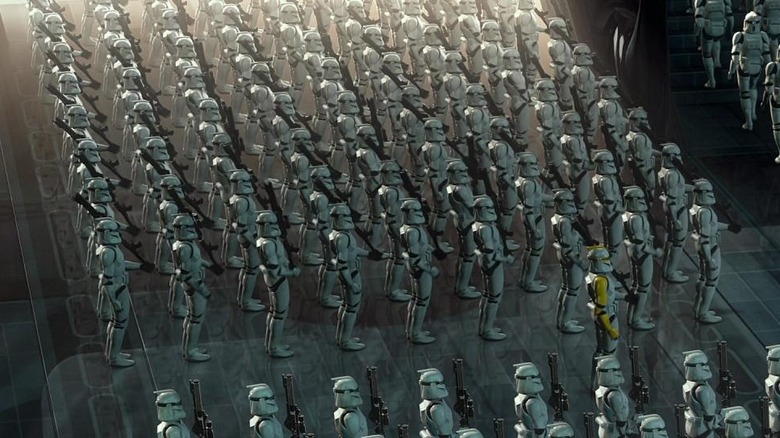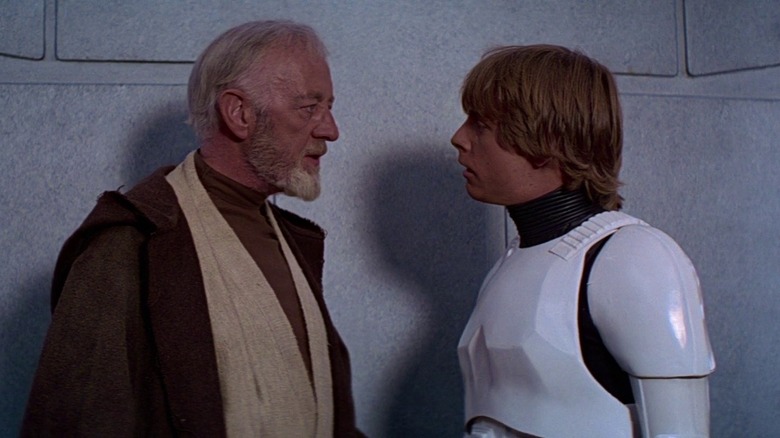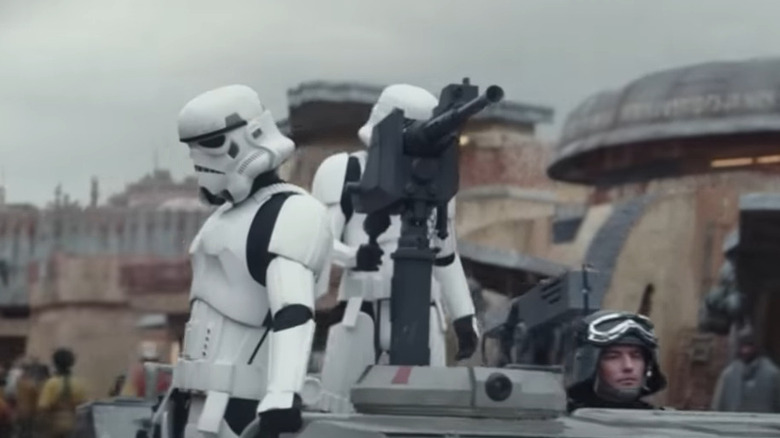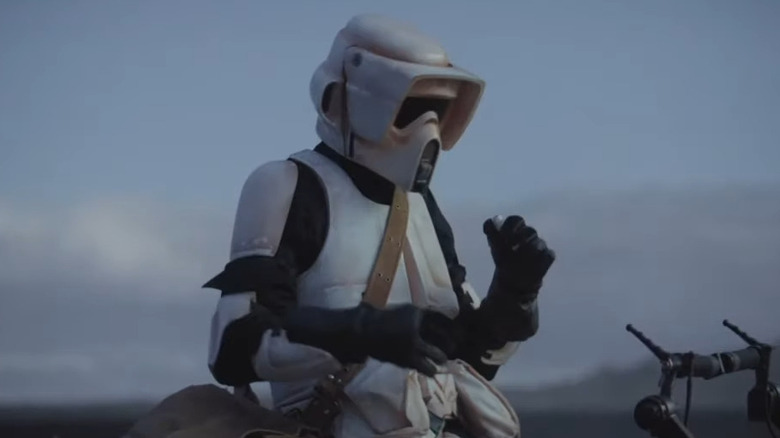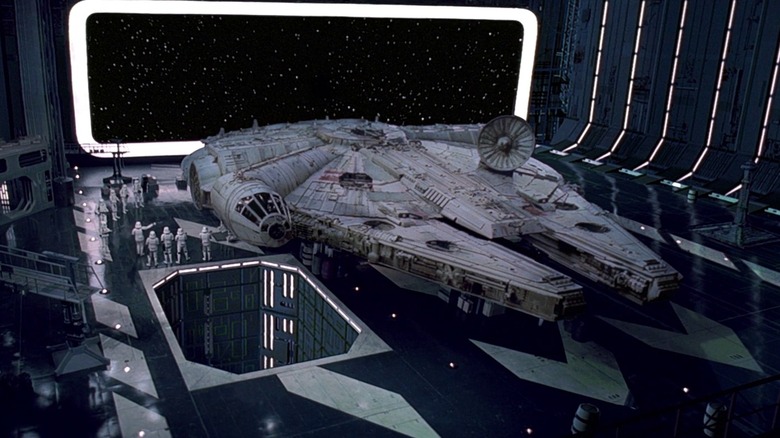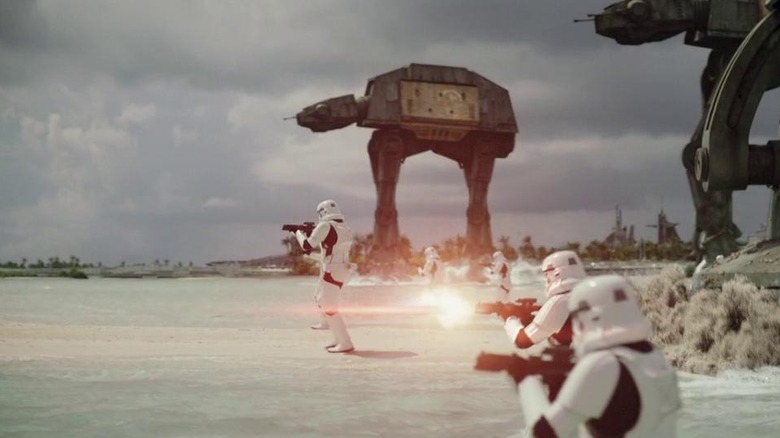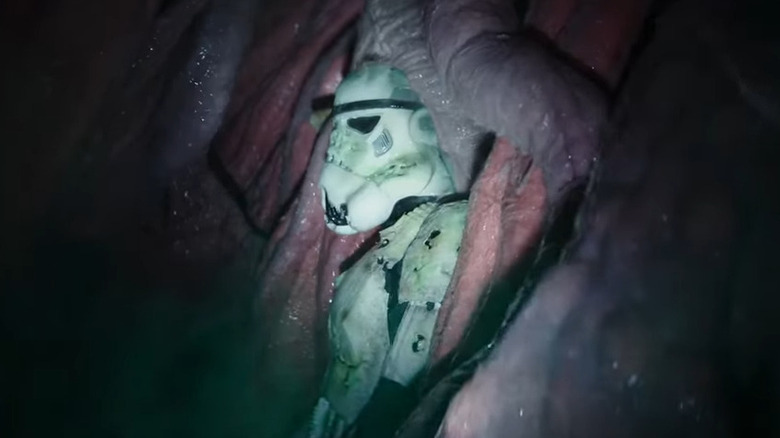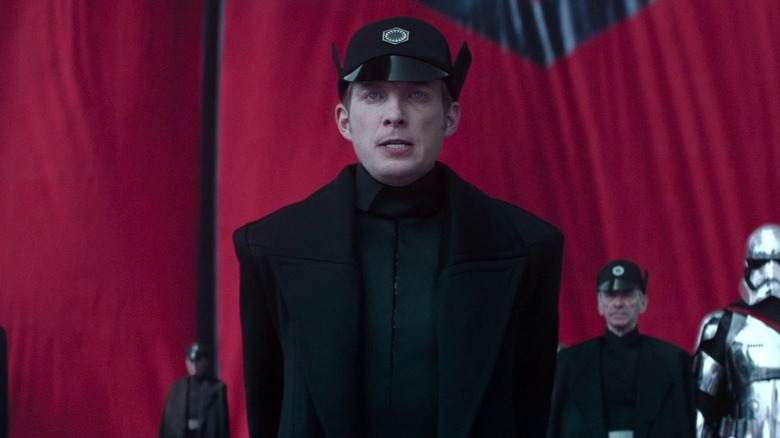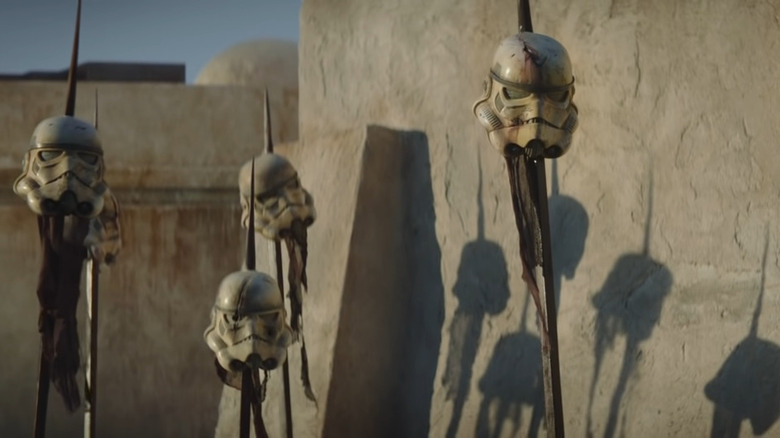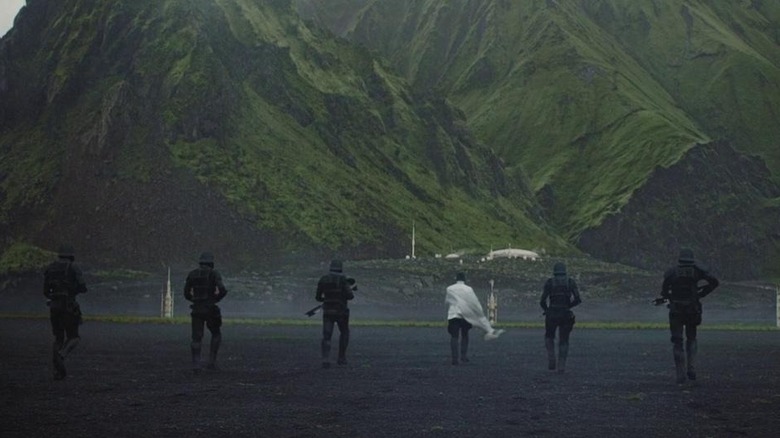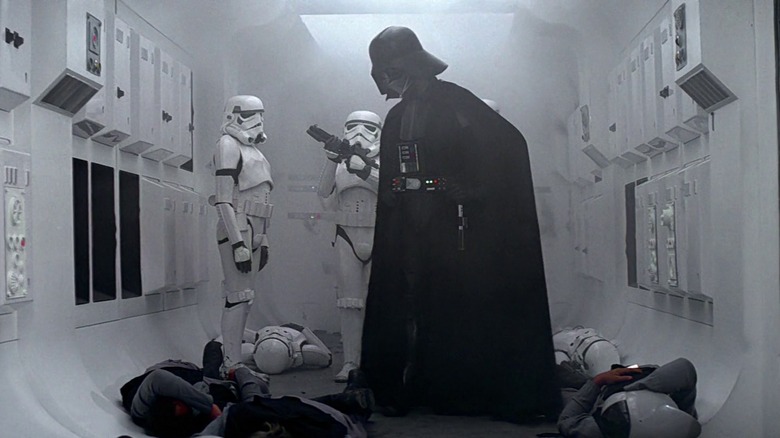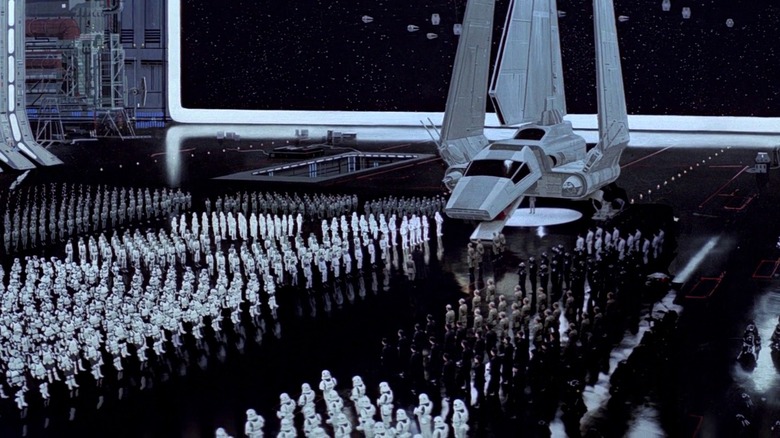Stormtroopers Facts Only Star Wars Fans Know About The Empire's Loyal Army
Apart from lightsabers, there is perhaps no more iconic piece of the "Star Wars" universe than the Imperial stormtrooper. With their striking white armor, the Empire's foot soldiers have been an unmistakable symbol of the franchise since the first movie was released in 1977. And yet, very little is actually revealed about the stormtroopers in the mainline "Star Wars" films. To learn more about the imposing enforcers of Emperor Palpatine's regime, you need to dig deeper into the TV shows, novels, comics, and video games that make up the rest of the story.
In these ancillary "Star Wars" tales, we learn a lot more about stormtroopers' training, inner organization, recruitment practices, rank differentiation, and many other details. At times, stormtroopers (or former stormtroopers) have even been made main characters in their own right — and no, we're not just talking about FN-2187. Elsewhere, little glimpses into the operations of the Empire and the rebellion reveal new tidbits about how the Imperial military actually functions.
Whatever your curiosity, there's a lot more information about the Emperor's "bucketheads" (as they're sometimes called by their enemies) than meets the eye. Here are some facts you may not have known about the Emperor's loyal Imperial Stormtrooper Corps.
Why clone troopers are replaced with stormtroopers
Pretty much every "Star Wars" fan knows that the clone troopers of the late Republic era are eventually replaced with normal recruits. However, the exact details of why and when this happens are a bit more obscure, in part because of how different the current canon is from the old "Star Wars" Expanded Universe (now known as "Star Wars" Legends).
In the old EU, Jango Fett clones become stormtroopers shortly after the end of the Clone Wars. Supplemented with other batches of clones, they remain the primary force of the Imperial military for about a decade. After that, more and more human recruits begin to fill up the ranks. This is mostly shown in Imperial era video games like the "Star Wars: Battlefront" and "Force Unleashed" series, as well as their respective tie-in novels.
In the new canon, however, this timeline is significantly different. "Star Wars: The Bad Batch" shows the Empire replacing clones with recruits almost immediately after the end of "Revenge of the Sith," both to cut costs (clones are extremely expensive) and as a way of securing citizens' loyalty. The first wave of real stormtroopers are known as TK troopers — a reference to the "TK" callsign numbers present in the original "Star Wars." They wear armor with elements of both clone and stormtrooper gear. Clones train many of these early stormtroopers, and the Empire uses their popularity to drive recruitment (as explored in Pablo Hidalgo's "Star Wars Propaganda"). Due to the clones' accelerated aging, it isn't long before almost all of the Empire's soldiers are natural-born.
Only humans are allowed to be stormtroopers
If you've ever wondered why all stormtroopers look the same, despite the many alien body shapes in "Star Wars," the question has a dark answer. Like so many different aspects of Palpatine's Empire, the Stormtrooper Corps is exclusive to humans — the first-class citizens of the regime.
Canon stories like the "Star Wars: Aftermath" series and Timothy Zahn's latter-day "Thrawn" novels show this reality in much sharper detail, but it's present in every Imperial shot of the original trilogy. From boardroom to barracks, the Empire is built on a core foundation of human supremacy, to the point that there's an entire "High Human" cultural movement pushed under Palpatine's fascist regime. Palpatine effectively wields the anti-droid-and-alien sentiment of the Clone Wars as part of his rise to unlimited power. Later, it becomes a staple of his rule.
Even though stormtroopers are meant to be cheaper than clones and the foot soldiers of the military, recruitment is still restricted to humans. Perhaps the Empire enjoys the stark image of identical soldiers marching through the galaxy, or maybe this decision hinges on simple bigotry. Regardless, droids and aliens are still used by the Imperial war machine, but as slaves and menial workers instead of decorated troops.
Stormtrooper training is very dehumanizing
As you might expect from the military arm of a fascist regime, the training program for stormtrooper recruits is a rigorous and dehumanizing process designed to create absolute loyalty. "Star Wars Rebels" shows a lot of this first-hand, detailing recruits' youth, how they're pitted against each other to create a cutthroat environment, and how their training is designed to remove variance and independent thinking. The idea is to create perfect, identical soldiers — a job that continued cloning would accomplish easily, but at a much steeper price.
Though they don't show up much in the mainline "Star Wars" stories, female stormtroopers also exist in Palpatine's army, but they're trained separately and assigned to all-female squads. "Rebels" tie-in novels "A New Dawn" and "Servants of the Empire: Rebel in the Ranks" explore this separation. It's just one more way in which the Empire imposes its own rigid order and rules onto its soldiers.
That armor is a lot more complicated than it looks
Stormtrooper armor is designed to be monolithic. It's bright white with black augments, creating a singularly intimidating image. Put a hundred troopers together, and you have a monochromatic sea of armored killers — enough to make any regular citizen of the galaxy think twice before acting against the Empire. For all this aesthetic simplicity, however, this armor has a ton of high-tech gear happening beneath the surface.
As seen in "The Book of Boba Fett," stormtrooper helmets have air filters, and, in some cases, oxygen tubes that help soldiers breathe in even the harshest environments. The "Star Wars Battlefront II" tie-in novel "Inferno Squad" details other aspects of the typical stormtrooper kit, including advanced communications systems and an augmented visual display meant to enhance effectiveness and awareness in combat.
In addition to the inner gear, the stormtrooper's outer armor is state-of-the-art, but fallible. As seen in the movies, those heavy white plates can soften the blows of standard blaster bolts, but the armor's weak points are exactly that. The get-up's weight also makes it harder for stormtroopers to move around. Moreover, as Luke Skywalker himself observes in the original "Star Wars," the helmets sometimes make it harder to see instead of easier.
Their poor accuracy in the first Star Wars is intentional
Perhaps the most infamous fact about stormtroopers is that they can't aim to save their lives. A quick Google search will instantly dredge up a nearly endless slew of memes and jokes about how frequently the Empire's elite soldiers miss their targets. While this is far less excusable in later movies or shows like "Star Wars Rebels," stormtroopers' inaccuracy in the original film has a proper explanation — one that many fans have noticed over the years, but which still goes widely ignored.
Most battles with stormtroopers in the original "Star Wars" take place on the Death Star itself, when Luke, Han, R2-D2, C-3PO, and Obi-Wan Kenobi attempt to rescue Princess Leia. While the crew is off infiltrating detention levels and trash compactors, Darth Vader and Grand Moff Tarkin sneak a tracking device aboard the Millennium Falcon, which leads them right to the rebel base after the intruders escape. Why can't the stormtroopers land a single shot? Because they have to let the rebels get away in order to follow them to Yavin.
On the flight afterwards, Leia even says that the escape was far too easy, and that the Empire is likely tracking them. Again, this doesn't excuse poor accuracy in the later films, but in the original "Star Wars," those stormtroopers are missing on purpose.
Stormtroopers don't get called in for just anything
If you've only watched the original "Star Wars" trilogy, you might be under the impression that stormtroopers are the base unit of the Imperial Navy, and are little more than grunts. That couldn't be further from the truth. While there are lots of stormtroopers present during the events of the first three films — especially in major moments like the invasion of the Death Star, the Battle of Hoth, and the occupation of Cloud City — this isn't the norm. We see a lot of stormtroopers in the movies because of the importance of the action therein. But to a regular citizen of the galaxy under Imperial rule, the sight of a stormtrooper is cause for major concern.
This is perhaps best exemplified in "Andor" Season 1, which journeys to numerous Imperial planets and facilities where hardly any stormtroopers can be found. The garrison on Aldhani — the site of a major Imperial vault — is guarded by a small deployment of foot soldiers and officers and supported by a local airbase. Similarly, the prison complex on Narkina 5 is run without a single stormtrooper on the premises. The only time the classic black-and-white armor makes an appearance on "Andor" is during Cassian's return to Ferrix, where the local military presence is drastically upgraded due to social unrest.
This contrast helps underline just how elite stormtroopers really are. Prior to the full emergence of the rebel Alliance during the Battle of Scarif, you're only likely to see the armored soldiers in areas of major political importance.
A stormtrooper is the only reason Boba Fett survives the sarlacc
In the old "Star Wars" Legends timeline, Boba Fett survives his fall into the sarlacc in Tatooine's Great Pit of Carcoon. After the canon was rewritten, fans waited anxiously for years to see whether or not he would escape once again. The answer finally came in "The Mandalorian," which reintroduces Fett years after the events of "Return of the Jedi." He might be older, but he's no worse for the wear.
The exact method by which Fett escapes digestion is revealed in "The Book of Boba Fett." As in the Legends continuity, his beskar armor helps protect him at first, but he probably wouldn't make it all the way out if not for a clumsy stormtrooper. While exhaustedly crawling through the creature's innards, Fett comes across the remains of an Imperial stormtrooper who's already mostly digested. The bounty hunter is able to get a breath of fresh air by using the trooper's own's oxygen tube, which gives him the strength and peace of mind needed to devise a means of escape. Without the added boost granted by the dead stormtrooper, we might never have seen the fan-favorite character again.
How did this trooper come to die in the bowels of the sarlacc? Most likely by displeasing the almighty Jabba the Hutt in some way. Or maybe the stormtrooper was just very, very clumsy.
They keep on fighting long after the Battle of Endor
The Battle of Endor marks the Rebel Alliance's victory over the Empire, but it isn't the end of the war. Though Emperor Palpatine is (supposedly) killed alongside Darth Vader and the Death Star II is destroyed, remnants of the Imperial military continue to fight. Other major conflicts take place before the war is officially declared over, such as the Battle of Jakku, which is the Empire's final stand. These post-Endor actions are primarily explored in novels like the "Alphabet Squadron" trilogy and the "Star Wars: Aftermath" series, which take place in the interim between the original trilogy and the sequels.
Even after the Empire cedes to the New Republic, however, stormtroopers continue to fight across the galaxy. Numerous sects of Imperial hold-outs are shown in "The Mandalorian" on planets like Morak and Nevarro. Some actively serve the survivors who flee to the Unknown Regions, while others seem to simply be working for the highest bidder. The reasons for this aren't entirely clear, and they're likely different for each soldier. Perhaps the indoctrination of the stormtrooper training program keeps many loyal, even after the Empire falls. Maybe the stormtroopers simply fear imprisonment or retribution if they stop hiding from the New Republic. Whatever the reason, stormtroopers remain part of the galactic landscape for years, even though they're literally illegal.
Stormtroopers become illegal after the fall of the Empire
Defeating the Empire isn't enough for the New Republic; they have to fully wipe out all symbols and iconography associated with Palpatine's regime as well. That includes the stormtroopers themselves, who are perhaps the most instantly recognizable reminder of the Empire. The visual dictionary for "Star Wars: The Force Awakens" outlines many of the changes instituted by the government of the New Republic, including the outlawing of Imperial training and stormtrooper deployment.
Obviously, moving against the new government is illegal regardless of what kind of armor or training the attackers have. But it's interesting that the New Republic specifically moves to stop anything close to Stormtrooper Corps training in particular. In the canon "Star Wars" novel "Bloodline," which explores the politics of the New Republic in the years before the sequel trilogy, it's revealed that stormtrooper helmets, armor, and gear eventually become valuable collector's items for those with an interest in (or perhaps fascist sympathy for) Imperial history.
Clearly, the New Republic's efforts to wipe out all memory and tradition of the Stormtrooper Corps doesn't work. Just a few decades after the fall of the Empire, the regime reemerges in the form of the First Order, which uses all the same iconography and instills an even harsher fascist culture.
There are way more kinds of stormtroopers than you think
Though the classic black-and-white stormtrooper is the most common and iconic version of the Imperial foot soldier, there are many, many other varieties. Some of the bigger ones appear in the "Star Wars" movies, such as the sandtroopers on Tatooine in the original film, the snowtroopers from the Battle of Hoth, the scout troopers present during the Battle of Endor, and the so-called shoretroopers stationed on Scarif during the events of "Rogue One: A Star Wars Story." However, these are far from the only varieties present in the Imperial military.
Flametroopers are stormtroopers outfitted with — you guessed it — flamethrowers. This brutal variety is often sent on scorched-earth missions, such as quelling the Wookiee uprisings on Kashyyyk seen in "Star Wars Jedi: Fallen Order." Death troopers are another elite variety seen in "Rogue One." These fully-black-clad killers are typically assigned to senior Imperial staff, and, according to the film's visual guide, are cybernetically or genetically augmented to be even fiercer soldiers. Other types include the airborne rocket troopers, or the purge troopers, who are specifically trained to hunt and kill Jedi. And, of course, there are the Sith troopers of the First Order, visible in various video games and "Star Wars: The Rise of Skywalker," who wear bright red armor in honor of their namesake's lightsaber hue. Explaining every type of stormtrooper would take all day, but suffice it to say that there are many more kinds than just the ordinary bucketheads.
Originally, stormtroopers were supposed to use lightsabers
Though fans today take a lot of "Star Wars" lore as irrefutable, very little was set in stone back when George Lucas and company were sketching out the original film. These original drafts are widely available today, and have even been officially adapted in comic form. In early versions, Han Solo is an alien, and Luke is Anakin's master instead of his son. Ralph McQuarrie's original concept art offers further insights into what might have been, including one particularly intriguing tidbit about the Stormtrooper Corps.
McQuarrie's early concepts reveal that, at one point, he envisioned the stormtroopers wielding their own lightsabers. Along with massive shields, this would have made them much more similar to knights. It's likely that this idea existed before Lucas had nailed down the lightsaber's details and what the Jedi Order looks like. Or maybe it's meant to be indicative of the larger Sith faction mentioned in his early drafts. Either way, the idea of whole platoons of lightsaber-wielding stormtroopers is a fascinating one, which the Rebel Alliance was lucky to avoid. The whole "blaster inaccuracy" schtick likely wouldn't have been a problem if the bucketheads were armed with laser swords.
The creepy truth about stormtrooper helmets
You might think that enlisting in the Stormtrooper Corps would protect you from the distrust and oppression of your Imperial overlords, but you'd be wrong. In the 2015 "Star Wars" novel "Battlefront: Twilight Company," it's revealed that due to Imperial paranoia in the Galactic Civil War, the government starts monitoring the helmet comms of stormtroopers at all times. This creepy truth about stormtrooper helmets is certainly unsettling, and also speaks to just how unnerved the Empire is by increased rebel activity in the galaxy.
The destruction of the Death Star is a major blow to the Imperial war machine, and afterwards, the rebels continue to hold power by staying spread out and stealthy. More recent stories like "Andor" Season 1 show that various stormtroopers and Imperial officers defect or spy for the rebellion. Fear of this kind of subterfuge pushes the higher-ups to authorize full-time audio monitoring. In essence, if you're a stormtrooper, anything you say while on duty can and will be used against you. This extra level of precaution is certainly intense, but it doesn't save the Empire from the doom that's already headed their way.

